Gorakhpur in eastern Uttar Pradesh is full of ironies, and a microcosm of everything that is wrong and right with India’s largest state.
It is the setting of Hindi films like Ishqiya and Ishaqzaade, with all their violence and passion, yet it is 110 km from Lumbini, the birthplace of Lord Buddha in Nepal. Its municipal corporation is non-functional, making it perhaps the filthiest city in India, yet it has a virtual industry of doctors, so much so that its hotels are permanently crowded with conferences for medical reps from every major pharma company in the world. Its history is glorious: the raag Gorakh Kalyan originated in Gorakhpur, the famous Gorakhnath mutt is located there, and the city was integral to the Maurya and Gupta empires. But its current politics are fractious and debilitating; bribery and corruption are the currency of power.
The residents and bureaucrats are fed up with the conditions of Gorakhpur, and fervently hope that the on-going state elections in UP will bring about a change for the better. Ditto with voters across UP, many of whom are dissatisfied with the status quo and the caste-based benefits that keep the goodies only for some. They will have their answer on March 11, when the election results are declared.
Till then, observations from a six-day trip to eastern UP, starting from Lucknow to Amethi, to Gorakhpur, Azamgarh, Varanasi and Mirzapur, offered some insight into the mind of the state of UP. Almost half of UP’s 140 million electorate is under 35 years of age. Of them, 25 lakh are new voters (18 to 19 years) and another 38 million in the age group of 20 to 29 years.
Two interwoven trends are visible: one, that the young voter is hewing closer to a national identity and away from the jaati or caste identity. Two, that it is hard to find good leaders on that path to a national identity. All these years, jaati and caste have served to fill political and bureaucratic positions from within families and communities, but they haven’t provided leadership. This chasm is becoming apparent to the young, who now want more than the security of caste.
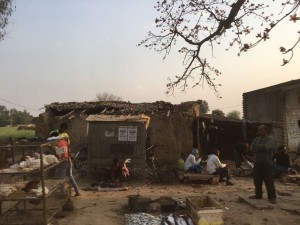
The protagonist and antagonist in the UP election is clearly Prime Minister Narendra Modi. Most candidates campaigned not on their record, but against Modi; it’s a little like Donald Trump in the recent U.S. election, where his opponents focused so much on him and his agenda and so little on theirs, that he won the election. The same outcome may or may not repeat in UP, but the echoes are obvious.
In UP, the three-cornered fight is between the Bharatiya Janata Party, Mayawati’s Bahujan Samaj Party, and the Akhilesh Yadav-led Samajwadi Party-Congress combine. For the latter two, it is a fight to hold on to their existing vote, and for the BJP, a battle to gain control both in the state and in the Rajya Sabha. For UP also has Ayodhya, site of the destroyed mosque and of the planned Ram temple.
The dark horse in the current electoral stable is Mayawati. Her voters are the silent type; they never speak their minds, but are steadfastly loyal to her. The Dalits are still among the few in UP villages who live in mud huts; they have much to gain economically from a BSP win. Mayawati campaigned against Modi, calling him a “big-talking PM” with no substance, but her ire was directed against the SP, its corruption and goondagiri: Akhilesh Yadav is battling a reputation for this and anti-incumbency.
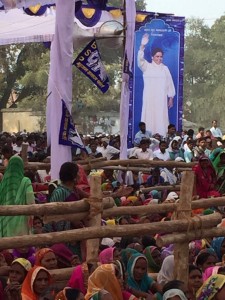
He too campaigns against Modi but has been pushing his cause in the last few months through flashy advertisements of his achievements – of the Lucknow-Agra Freeway, of electricity, of computer tablets, of a sports stadium in Lucknow and also a metro for that nawabi city; none of his projects are complete. He has also recently installed the 100 emergency phone line and the 102 medical emergency helpline.
The failures of the SP government – and those before it – are visible across the state. In Kachhwa Bazaar, in Mirzapur district, long-suffering local villagers refer to the candidates in this election as ‘viruses’. They point to the incomplete mega bridge across the Ganges. It’s the Chunar-Varanasi bridge, which will cut short the time from Mirzapur to Varanasi by two hours. But it has been incomplete for 13 years – inaugurated by SP’s Mulayam Singh Yadav when he was chief minister, re-inaugurated by Mayawati when she followed him as chief minister, and then again by Akhilesh Yadav as chief minister. It is still incomplete, and locals call it “Mulayam Singh’s lollipop” – referring to the stilts of the bridge with bumps on top and no connectivity. Getting produce to market, then, is virtually impossible. A temporary pontoon bridge has been built over the water, but it is no substitute for a good road. The tomato farmers who cultivate on the edges of the skeleton bridge say they will vote for Modi.
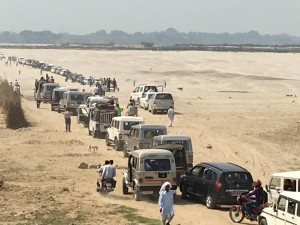
Predictably then, the BJP is campaigning mostly on PM Modi’s firepower, and on a development agenda for UP, aligned with national priorities. The Prime Minister has addressed 24 rallies – they are the best attended of any — and three roadshows in UP, where he talked up the BJP’s plans for the state’s women and youth: gas cylinders over coal stoves; stemming migration by providing employment locally; improving agriculture; and pardoning farmer debt. He focuses on the micro, district issues too: law and order, without which there can be no industry or jobs, reviving the sugar factories, curbing the continued corruption and the ‘ghoos’ or bribery to get a government post.
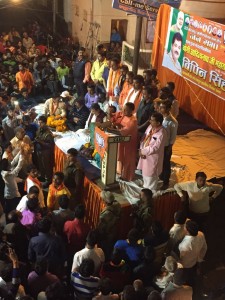
In this silent voter-valuable candidate scenario, it is hard to predict a winner. But the BJP has made inroads into UP, and it has made an impression with young people across caste lines. In Mahuapar Khas near Gorakhpur, several of the young men are studying for government service exams, especially for the IAS. They have a pan-Indian view: “Modi has pledged to take India forward and we will vote for him for that.” At a nukkad or street-corner sermon in Gorakhpur city by Yogi Adityanath, current head of the Gorakhnath mutt, the youth have absorbed the BJP’s national agenda, and point out that Modi is focused on development and has put India on the global map.
Yogi Adityanath, who represents Gorakhpur in Parliament, is a controversial figure. He points out that his city is filthy because the municipal funds are controlled from Lucknow by Azam Khan, the even more controversial SP minister known for his misogynistic statements.
In Varanasi, much cleaner than it has been in decades, it is still not a city that represents a head of state. BJP leaders say municipal permissions for improvements have been delayed and denied by the SP state government. But once the BJP wins the state, those funds will be well used for the cities and towns, says the Yogi.
Like the slums in Mumbai, in the emerging towns in UP, rural families are nearly middle class. In these towns around Sant Kabirnagar district, each home has electricity, a water pump, a bathroom, a government school and access to limited healthcare through the 102 emergency helpline. But the roads are bad, power and water are both intermittent, so it can’t really start an industry. Consequently, the young are unemployed, and their lives are still totally dependent on government services – most of which are provided after paying ghoos. If you’re lucky, the village pradhan will belong to your caste, and you will receive the benefits of central and state government schemes; if not, well, hard luck.
The outcome in UP has implications for the whole of India. A win by the BSP or by the SP-Congress combine, will continue the status quo – more caste, less development. UP will continue to lag the country’s major developmental indicators.
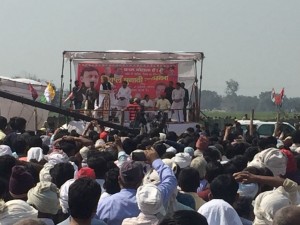
Most investors are looking hopefully for a BJP win. That means a steady hand at the wheel in Delhi through the 2019 national elections, and therefore predictability of investment. Foreigners say they will bring their money into India with greater confidence and Indian business too will begin to reinvest at home. For UP, it will be a welcome shift away from the narrative of caste to a narrative of development.
Manjeet Kripalani is Co-founder and Executive Director, Gateway House: Indian Council on Global Relations, and is the former India Bureau Chief of Businessweek magazine.
This article was exclusively written for Gateway House: Indian Council on Global Relations. You can read more exclusive content here.
For interview requests with the author, or for permission to republish, please contact outreach@gatewayhouse.in.
© Copyright 2017 Gateway House: Indian Council on Global Relations. All rights reserved. Any unauthorized copying or reproduction is strictly prohibited


